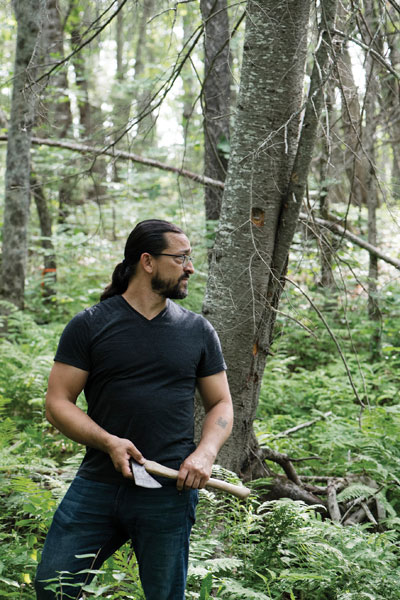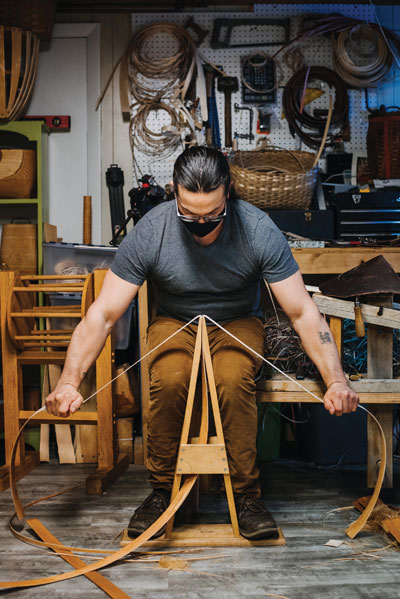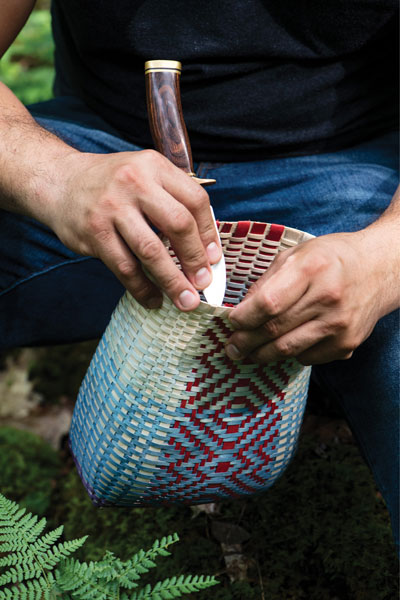In the beginning there was a black ash tree, the Wabanaki remember. And since peoples of four Wabanaki nations — Maliseet, Micmac, Penobscot, Passamaquoddy — have lived in the land now called Maine for some 12,000 years, you might say that if anyone recalls the way things happened back then, it’s them.

When the legendary hero Gluskabe shot his arrow into the furrowed trunk of that ash, its impact shook the tree’s pointed, pinnately compound leaves. But the arrow hole made a portal of kinds: The Wabanaki people stepped forth from the tree trunk and into their world. That’s when they learned, from Gluskabe, how to weave the tree’s straight-grained wood into baskets. Art, in other words, was with the Wabanaki people from the very first.

Weaving ash baskets remains a vital part of Wabanaki identity. In an artist’s hands, ash bends and whirls into myriad forms, by turns spiky and smooth. Some baskets, playfully, resemble ears of corn or plump strawberries. Others are adorned with tight scrolls of wood that appear impossibly delicate, petal-thin. Today, Wabanaki artists work in a medium rich in both innovation and memory.
“Because our creation story is centered around the ash tree, it’s sort of a symbolic message from our ancestors describing the importance of this cultural material,” says 13th-generation Passamaquoddy basketmaker Gabriel Frey. “I view my baskets as a physical representation of my homeland — of Wabanaki territory.” Tools and knowledge required to make Wabanaki baskets are often passed between family members, who prepare traditional materials drawn from the landscape.

However refined, an ash basket still begins in the forest; basketmakers learn to spot the straightest trees around. Some pray or give an offering before felling their chosen trees, but even then, the work’s hardly begun. Once the tree is felled, pounding it with the blunt edge of an axe loosens its wooden rings until they can be peeled off in long, fibrous strips; further splitting and peeling and soaking turns the fibers to pale, pliable ribbons. Made with such materials, a featherweight basket lasts a century, defying an apparent delicacy. “Ash is a hardwood, but it’s incredibly flexible and durable,” Frey says. “When you process the material in the traditional way, the tensile strength is remarkable.”
Frey grew up in a home where basketmaking was integrated into the rhythms of daily life, but he had little formal instruction. His grandfather, Fred Moore, specialized in the light, strong “utility” baskets traditionally used for storage and transportation. When the family learned Moore had emphysema, the 18-year-old Frey moved into his grandfather’s home and began the slow process of learning to weave.

Many baskets start with strips of ash laid flat, woven into a tight grid like the latticed top of a cherry pie. But then, their shapes swell into capacious carriers or slim tubes. Like his grandfather, Gabriel Frey weaves utility baskets, though the purses and belt bags he makes are far from utilitarian. In his designs, rainbow colors from natural dyes cascade over the baskets’ rounded bellies; neat chevroned lines march across packs girded by leather straps. Frey’s brother Jeremy is also a weaver. He specializes in intricate “fancy” baskets, and his work is in the permanent collection of the Smithsonian American Art Museum.
Gabriel Frey’s story of apprenticeship is not unusual. Wabanaki weaving owes its ongoing vibrancy to elder weavers — like Fred Moore — who are determined that the tradition remain strong. “Basketmakers really wanted to make sure it would be passed to the next generation,” says Kathleen Mundell of the Maine Arts Commission, who in 1990 helped found a traditional arts apprenticeship program to pair skilled artists with younger apprentices who were eager to learn.

The program’s master weavers are a who’s who of modern Wabanaki basketry, including Madeline Shay of the Penobscot Nation and Molly Neptune, a Passamaquoddy weaver who was named a National Endowment for the Arts Heritage Fellow in 2012. At one time, Mundell says, the significance of Wabanaki basketmaking was poorly understood in the broader arts community, but that’s changed. “I think it’s just been recognized as an important art form and cultural tradition in the Northeast,” she says. “The Wabanaki tradition has been here for many, many generations.”
But while Wabanaki baskets endure, the trees they spring from face an existential threat. Hundreds of millions of North America’s ash trees — including black ash, the sacred basket tree — have already fallen prey to the emerald ash borer, an invasive beetle. Most infested trees die. Maine officials detected the state’s first ash borer in 2018. But by that time, local tribes had been concerned for years about the pest’s possible impact on the forest.
Tribal communities in Maine heard stories from Michigan weavers about beetles killing basket trees, says John Daigle, a professor of forest recreation management at the University of Maine at Orono. Daigle is a member of the Penobscot Nation and knows the cultural gravity of losing ash trees. His grandparents were basketmakers, his home adorned with the ash baskets they invariably gave him to mark special occasions.

“It’s such a strong part of people’s identity. The style of basket you make kind of defines who you are,” he says. “It’s one of those things that makes it scary when you think about the emerald ash borer.” Daigle now conducts research into emerald ash borers, combining academic methods with indigenous expertise. In 2019, all four of Maine’s Wabanaki nations — along with the Abenaki people of Vermont — collaborated on creating a field manual for ash tree inventories on tribal lands.
Despite the urgency of the threat, Daigle remains hopeful. He thinks it may be possible to identify and propagate certain ash trees able to withstand the beetle. Preserving seed-bearing trees could help. Maine has remained dedicated to the issue, partly due to ash trees’ cultural value. Daigle says it’s one of the few remaining states enforcing an internal quarantine to slow the spread.
For now, Maine’s population of basket trees is holding steady against the outside threat. Maine’s Wabanaki peoples, too, have made perseverance a habit: They’ve weathered tumultuous centuries. Historic U.S. government policies suppressed forms of tribal culture in Wabanaki lands, from language to hunting and harvesting. Even in today’s Maine, Frey says, discrimination lingers, along with the stereotype that Native culture belongs to the past.
If anything, weavers like Gabriel Frey show the astonishing power of art in the face of adversity, and of families unwilling to forget. “Having my cultural materials and expressing indigenous knowledge through art — I guess it’s a form of resistance,” Frey says. “It’s a form of resistance to the idea that we’re not supposed to be here anymore. We’re still here.” In that light, basketmaking blazes defiance through art, forging beauty from a painful past. Baskets can, improbably, last for a hundred years; flowing from skilled hand to skilled hand, Wabanaki heritage has proved more resilient still.
Jen Rose Smith has written for the Washington Post, CNN Travel, Condé Nast Traveler, AFAR, Rolling Stone, USA Today, and Outside Online and is the the author of six travel guidebooks to Vermont and New England. For more, visit jenrosesmith.com.
This article appears in the January/February 2023 issue of The Saturday Evening Post. Subscribe to the magazine for more art, inspiring stories, fiction, humor, and features from our archives.
Become a Saturday Evening Post member and enjoy unlimited access. Subscribe now



